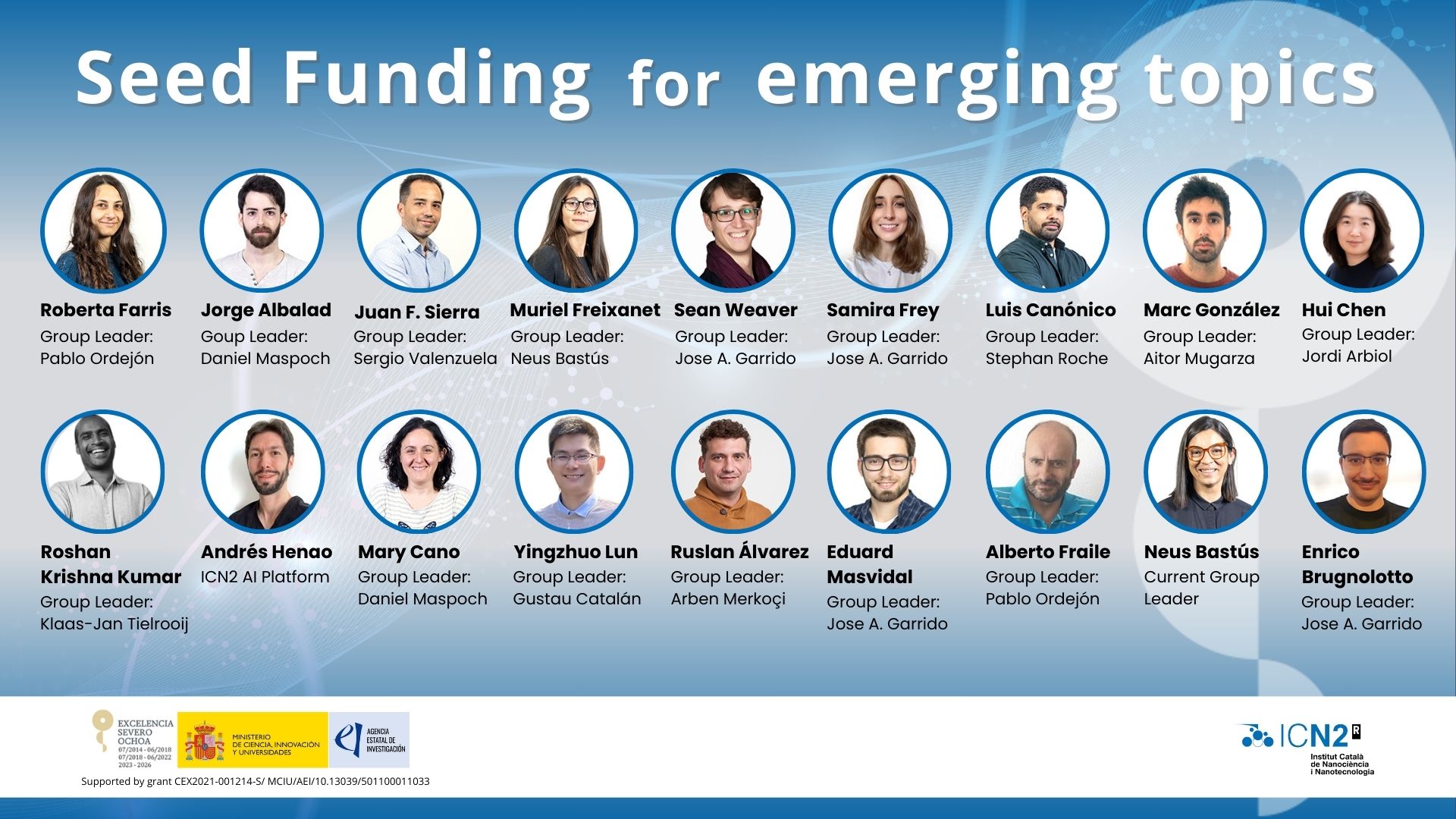These awarded projects have a clear and emerging research perspective and are expected to significantly impact society in the future.

ICN2's third Severo Ochoa Programme (2023-2026) launched an internal competitive fund to propel emerging topics forward. The Severo Ochoa Seed Funding Programme, co-funded by the Spanish Ministerio de Ciencia, Innovación y Universidades, offers researchers the opportunity to develop innovative projects that add value to the European industry within a limited timeframe of 365 days.
A total of nine projects were selected in last autumn's call for proposals. The projects will start on 1 May 2025. Participants are expected to deliver tangible results in June 2026, after 12 months of intensive research work. The Seed Funding Programme drives research at the frontiers of innovation, novelty, and excellence—empowering young researchers to pursue high-impact ideas with grants of up to €15k per project. Projects were evaluated based on excellence, impact, feasibility, and alignment with Severo Ochoa objectives, with special consideration given to early-career researchers and gender balance.
We extend our warmest congratulations to the ICN2 researchers selected for this grant. Their work exemplifies the Institute's commitment to cutting-edge research with societal impact.
The nine projects that were awarded are listed below:
- INSIGHT-H2: Unveiling the Catalytic Excellence of High-Entropy Oxides for Green Hydrogen Production - PI: Hui Chen/J. Arbiol | Co-PI: Roberta Farris/P. Ordejón
The project develops low-cost high-entropy oxide catalysts for green hydrogen production. The project's innovative approach to low-cost, high-performance catalysts could have a potential impact on the energy transition.
- Twisted Polar Metals (TPMs): Exploring polarization via flexoelectricity in twisted SrRuO₃ bilayers - PI: Yingzhuo Lun/G. Catalán
The project validates a novel approach for twisted SrRuO₃ bilayers via flexoelectricity, with atomic-scale simulations, offering ground-breaking potential in materials science.
- SOS-SD: Scalable Organic Synthesis via Spray-Drying Technology - PI: Jorge Albalad/D. Maspoch | Co-PI: Muriel Freixanet/N. Bastus
The project presents an innovative approach to producing drugs by reducing synthetic costs and reducing production time. The use of spray-drying combined with the use of inorganic heterogeneous catalysts (Fe3O4 NPs) provides an interesting scope. The outcomes of the project might open a new way of production of organic compounds.
- CAPMESHGO: Graphene Oxide Nanocapacitors for Neural Mesh Implants- PI: Sean Weaver/J.A. Garrido | Co-PIs: Samira Frey/J.A. Garrido, Enrico Brugnolotto/J.A. Garrido
The project aims to improve the properties of capacitive transducers, creating high-density arrays for minimally invasive neural interfaces. The outcomes of the project will develop neural interfaces to create porous materials with greater sensitivity and to create new technologies for implantable devices.
- AIMEX: Atom-Scale Imaging of Excitonic Light Emission - PI: Marc González Cuxart/A. Mugarza | Co-PI: Juan F. Sierra/S. Valenzuela
The study of exciton emission in TMDC bilayers at the atomic scale promises high-impact discoveries in quantum materials. We expect that a tr-TEPL observation of a single exciton in TMDC bilayers will probably result in a strong publication.
- DRAGON-DOTS: Smart Hybrid Nanoparticles with Carbon Dots for Monitoring Drug Release Dynamics - PI: Mary Cano/D. Maspoch | Co-PI: Ruslan Álvarez/A. Merkoçi
The project aims to develop a platform for the biosensing of cardiovascular diseases using an already existing prototype and to evaluate the drug delivery abilities of the hybrid nanosystems built with carbon-dots entrapped in PLGA nanoparticles, featuring a demonstrated mobile app-controlled prototype for biosensing applications. The carbon-dot-based nanosensors could enable breakthroughs in personalized medicine.
- FLEXUS: Flexible Nanomaterial-Based Ultrasonic Transducers for Biomedical Imaging - PI: Eduard Masvidal/J.A. Garrido
The project aims to develop a flexible ultrasound transducer for bioimaging, with a particular focus on measuring blood pressure. The project aims to fill a gap in the development of wearable ultrasound sensors. Addressing a critical gap in wearable ultrasound technology for blood pressure monitoring.
- M2S: ML + MD optimization of Synthesis routes of catalytic nanoparticles - PI: Alberto Fraile García/P. Ordejón | Co-PIs: Neus Bastús, Andrés Henao/AI Platform
The project optimizes PtAg hollow nanocage synthesis through machine learning trained on molecular dynamics simulations and experimental data, establishing a transferable methodology for nanomaterial design. The outcomes of the project will generate optimized synthetic methods for AgPt hollow NCs with controlled features. Also, it will help to consolidate a methodology for other nanomaterials. Pioneers a data-driven approach to nanomaterial synthesis with broad applications.
- Probing the Quantum Metric: Probing the Quantum Metric in Moiré Materials Through Optical Spectroscopy - PI: Roshan Krishna Kumar/K.J. Tielrooij | Co-PI: Luis Canonico/S. Roche
Moiré materials are presently a very hot topic, giving rise to a plethora of new and exciting physical experiments. The observation of Quantum Metric in Moiré materials will certainly generate high-impact publications.
(This action is part of the CEX2021-001214-S grant, funded by MCIU/AEI/10.13039/501100011033.)

